Prior to the early 2000s, Downtown Phoenix was not the bustling, vibrant city we know today. The area offered none of the great restaurants, entertainment, retail or Downtown Phoenix housing options that citizens now enjoy on a daily basis.
LEARN MORE: 7 Downtown Phoenix housing developments under construction
The downtown area has seen an influx of housing developments with a current focus on multifamily units. They are being built in conjunction with the continued revitalization of Downtown Phoenix as well as to combat the current housing crisis.
Over the last four decades, the City of Phoenix has worked to improve the image of the downtown area. In 1983, the Phoenix Community Alliance was founded and quickly got to work on several projects to revitalize downtown, including the opening of the Arizona Center in 1990 and the arrival of the Metro Light Rail system in 2008.
Prior to the Light Rail’s premiere, Downtown Phoenix also saw the opening of Margaret T. Hance Park, Footprint Center, Chase Field and the Arizona State University downtown campus. Along with all these big projects came restaurant and retail spaces opening to round out the downtown lifestyle.
Phoenix Vice Mayor Yassamin Ansari explains she has seen downtown development “skyrocket” in the two years she has been in office, and she credits the ASU downtown campus with being “one of the major catalysts, if not the biggest catalyst for downtown development.”
Downtown Phoenix housing
Now that downtown is the place to be, it is also becoming the place to live. Developers from across the country have set their sights on Phoenix for their next projects.
Clayco has been working in the Phoenix area for the past several years. The Arizona office started mainly in industrial work but eventually saw the opportunity to jump into the residential construction market.
“In the May 2021 time frame, the large demand for the rental-type property or projects was very high,” says Eric Jaegers, executive vice president at Clayco.
Clayco is constructing several housing developments across the Valley with a few in the downtown area, including X Phoenix Phases I and II, Skye on 6th and PALMTower. Phase I of X Phoenix has already been completed, and the other three projects are projected to be completed within the next two years.
Jaegers sees a future where housing development projects continue to pop up. “The market segment is still very strong,” he says. “The number of renters compared to the number of units available is still a very strong ratio from a needs perspective.”
He expects that Clayco will continue to construct these projects throughout the Valley.
Rapid growth
It’s no wonder people are flocking downtown with how many options there currently are for places to live. Since downtown’s revitalization really started taking off in 2000, there have been 11,784 housing units built, with 2,356 units completed just last year and even more currently under construction.
Jaegers credits much of the demand for downtown living to the revitalization of the area. “Renewed revitalization efforts based on how people want to live, work and play in the downtown areas present those opportunities in an easily connected way,” he says.
Ansari recognizes the current housing shortage that both Phoenix and Arizona — as a whole — are facing and supports the development of the new units, but she still has goals she is working on within the downtown region.
Ansari is working to make sure that along with all the new multifamily developments currently under construction, the city is also working on making sure there is plenty of affordable and workforce housing being included as well.
“As rents have risen dramatically in the past few years, we need to make sure that teachers, hospitality workers, bartenders, students and folks from all walks of life who work and go to school downtown can afford to live here,” she says.
She is also working to make sure that anything a resident could need is readily available by walking, biking or public transit. “Ultimately, we’re moving Phoenix towards a more sustainable, walkable future,” Ansari says.
She can see a lot of these essential businesses being built right into the ground floor of these housing developments. Since the space is there, she says, “We should never have a ground floor that isn’t activated.”
Developing the future
In the next few months, Ansari says the city will also be putting out requests for new project proposals that she thinks will build on her goals for more affordable and workforce housing. So, there is certainly more development on the horizon for Phoenix.
Although Jaegers says he credits much of the success of the housing developments to the revitalization of the downtown area, he also says that Phoenix is both a developer-friendly city and a construction-friendly city.
He explains that the city government demonstrates a generally positive attitude towards developers, making it simple to go through the process of getting the plans and documents approved. Jaegers also says there is a variety of availability in the parcels available as far as size and shape are concerned.
On the construction side of things, he says the parcels are generally rectangular and flat making them easy to work on.
“There’s just a lot of things that align in Phoenix for setting up projects to be successful developments,” Jaegers says.
Once completed, these developments provide new residents a front row seat to watch the city continue to grow.
Ansari is a current downtown resident herself. “It is absolutely incredible to live downtown,” she says. “We are very much striving, and I think are already considered to be a world-class city.”




